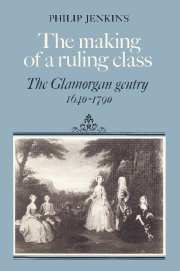Book contents
- Front matter
- Contents
- List of maps and tables
- Acknowledgments
- Abbreviations
- General introduction
- PART I SOCIAL AND ECONOMIC STRUCTURE
- Introduction
- 1 Land and people
- 2 The gentry
- 3 Economic development
- Conclusion to Part I
- PART II LOCAL AND NATIONAL POLITICS
- PART III SOCIETY AND CULTURE
- Conclusion to Part III: ‘conspicuous antiquity’
- Aftermath: towards the Victorian world
- Conclusion: from Civil War to Industrial Revolution
- Appendix 1 Parliamentary service by Glamorgan landowners 1640 – 1800
- Appendix 2 The ‘secondary’ gentry families
- Appendix 3 The ‘tertiary’ families
- Appendix 4 The Mansell family and their connections with the greater gentry
- Appendix 5 The roundhead and puritan family links of the Thomases of Wenvoe
- Notes
- Index
Conclusion to Part I
Published online by Cambridge University Press: 22 September 2009
- Front matter
- Contents
- List of maps and tables
- Acknowledgments
- Abbreviations
- General introduction
- PART I SOCIAL AND ECONOMIC STRUCTURE
- Introduction
- 1 Land and people
- 2 The gentry
- 3 Economic development
- Conclusion to Part I
- PART II LOCAL AND NATIONAL POLITICS
- PART III SOCIETY AND CULTURE
- Conclusion to Part III: ‘conspicuous antiquity’
- Aftermath: towards the Victorian world
- Conclusion: from Civil War to Industrial Revolution
- Appendix 1 Parliamentary service by Glamorgan landowners 1640 – 1800
- Appendix 2 The ‘secondary’ gentry families
- Appendix 3 The ‘tertiary’ families
- Appendix 4 The Mansell family and their connections with the greater gentry
- Appendix 5 The roundhead and puritan family links of the Thomases of Wenvoe
- Notes
- Index
Summary
Part I has given an account of the social structure and economic development of one Welsh shire in the century before industrialisation and has attempted to show that this society was distinctly unlike many traditional images of Wales, both contemporary and more recent. The mythical Wales was, above all, a poor and remote land. Its landowners were either exceedingly rich, or they were equal to English yeomen, but with absurd pretensions. The famous text for this view was the remark by a despairing Crom-wellian Major-General that it was easier to find ten Welsh squires of £50 a year rather than one of £500. This meant that offices like that of justice were hard to fill, so presumably party purges were more difficult to carry out. Such gentry as there were could be viewed as the ultimate backwoodsmen – simple, rough-hewn country tories, like the caricatures that Georgian dramatists like Gwinnett or Jerningham put on the stage. As a critic wrote of the royalist Judge Jenkins of Hensol, he was ‘bred in the mountains… [his] understandings were never burdened with weight of an argument’.
In this picture, this barbarous squirearchy ruled a countryside too poor to sustain a middle class, and populated by a tenant body as willing to serve their landlords as were Highland clansmen – and ‘clan’ terms are actually used of Glamorgan by Victorian writers. This myth has major implications for both Welsh and British history. First, there is no question here about the essential unity of Wales.
Information
- Type
- Chapter
- Information
- The Making of a Ruling ClassThe Glamorgan Gentry 1640–1790, pp. 71 - 72Publisher: Cambridge University PressPrint publication year: 1983
